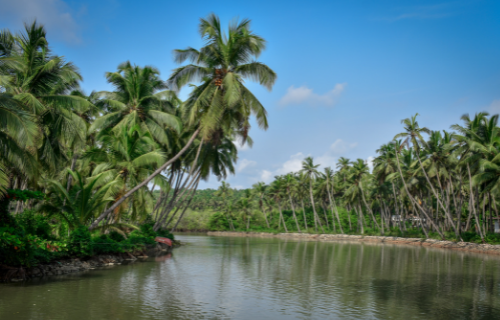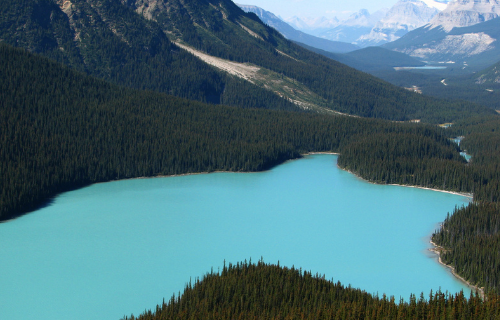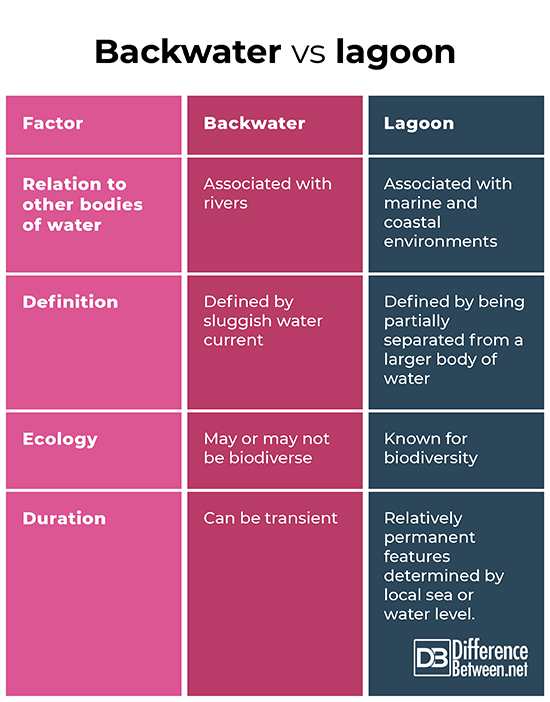Difference Between Backwater and Lagoon

Backwater
What is a backwater?
A backwater is part of a river where little or no current flows. Backwaters can result in the creation of swamps or shallow lakes, particularly along the meanders of old rivers. In other cases, backwaters may simply be due to recent flooding, or a temporary obstruction, such as a natural or artificial dam. An example of a wetland created by a backwater is a slough.
Why is it called a backwater?
The term backwater goes back to at least the 14th century and originally meant “water behind a dam.” The term backwater also makes sense considering one way that backwaters form. Tributaries draining into a river are generally higher elevation than the main river into which they drain. Consequently, the land surrounding the tributaries will be at a higher elevation than the floors of the tributaries into which the runoff water drains, eventually flowing into the larger river. In the case of flooding, water flowing into the main river can “back up” into the tributaries because of poor drainage. This will obstruct the flow of water and flood the surrounding land above the tributaries. This causes the current to become slower in that part of the river system since the water cannot drain.
What is the difference between a river and a backwater?
The main factor distinguishing a backwater from the rest of the river is that the current in the backwater is slow or absent, compared to the rest of the river.

Lagoon
What is a lagoon?
A lagoon is a body of water connected to a significantly larger body of water, usually the ocean, which is sheltered from the larger body of water by an obstruction, such as a sandbar or coral reef. There are two main types of lagoons, coastal and atoll lagoons.
Coastal lagoon
A coastal lagoon is a body of water sheltered from a larger body of water, such as the ocean, by sandbars or barrier islands. In marine coastal lagoons, the water will be a mixture of salt water brought in by the tides and fresh water draining into the lagoon from rivers or floods. Coastal lagoons, such as the lagoons of the Outer Banks in the U.S. states of Virginia and North Carolina, can be home to a variety of fish and bird species. Lagoons can be important for local economies. Important industries include tourism and fishing. The nature of a lagoon will depend on the local water level. Where the water level is high, coastal lagoons will resemble coastal lakes, or perhaps bays. Where the water level is low, they will be swamp-covered lowlands. Some lagoons are called lakes, such as Lake Nokoue in Benin and Lake Piso in Liberia.
Atoll lagoon
Atoll lagoons are commonly found in the tropical waters of the Pacific Ocean and the Indian Ocean. They are formed by coral reefs that grew around drowned volcanic islands as the islands were eroded and submerged beneath the ocean over millions of years. The atoll lagoons are marine environments. The species that live in the atoll lagoons do not generally differ from the species living outside of the lagoons. Nonetheless, there are species that especially thrive in the calm shallow waters of the atoll lagoons and thus are often found there. For example, atoll lagoons tend to be home to many species of sea jellies that prefer tranquil waters. Atoll lagoons are also important for many human societies. Countries, such as Maldives, rely economically and existentially on atoll lagoons, and are thus threatened by sea level rise which can significantly impact the environment of atoll lagoons.
Similarities between a backwater and lagoon
Lagoons and backwaters are both examples of calm bodies of water that are adjacent to larger bodies of water.
Differences between a backwater and lagoon
Although there are similarities between backwaters and lagoons, there are also important differences. These differences include the following.
- Backwaters are generally part of or adjacent to rivers, whereas lagoons are adjacent to the ocean or a similarly large body of water.
- Backwaters are defined primarily by sluggish current and may or may not be part of the main river, whereas lagoons, by definition, are partially separated from a larger body of water.
- Lagoons tend to be biodiverse, whereas backwaters may or may not have high levels of biodiversity.
- Lagoons tend to be relatively permanent features, defined by sea or water level, whereas backwaters can be transient features, forming due to recent flooding or a temporary dam.
Backwater vs. lagoon

Summary
Backwaters are sections of a river where the current is more sluggish than the other sections of the river. This may be due to recent flooding. It could also be due to a dam or obstruction causing a buildup of water in that part of the river due to poor drainage. Lagoons are bodies of water that are adjacent, but partially separated from, a larger body of water, such as the ocean. Lagoons can be coastal, or they can be within coral atolls. Backwaters and lagoons are similar in that they are defined by relatively calm waters and are adjacent to larger bodies of water, or within them. They differ in important ways as well. Backwaters are associated with rivers, defined primarily by their sluggish current compared to the rest of the river and not necessarily biodiverse compared to the surrounding area. Backwaters can be transient features as well as relatively permanent parts of the river system. Lagoons are associated with marine and coastal environments. They, by definition, are partly separated from a larger body of water. They are often known for being biodiverse and are relatively permanent features defined by local sea level or water level.
- Difference Between Environmental Performance Index and Development - November 24, 2023
- Difference Between Environmental Intervention and Development - November 8, 2023
- Difference Between Eco Efficiency and Eco Effectiveness - September 18, 2023
Search DifferenceBetween.net :
Leave a Response
References :
[0]“Backwater Flooding in Baton Rouge.” USGS, 19 Aug. 2015, https://www.usgs.gov/news/science-snippet/backwater-flooding-baton-rouge.
[1]Nittrouer, JEFFREY A. "Backwater hydrodynamics and sediment transport in the lowermost Mississippi River Delta: Implications for the development of fluvial-deltaic landforms in a large lowland river." IAHS-AISH Publ 358 (2013): 48-61. https://www.sedimentology.geo.ttu.edu/wp-content/uploads/2017/12/Nittrouer-2013.pdf
[2]Schwartz, Maurice L. and King, Cuchlaine Audrey Muriel. "lagoon". Encyclopedia Britannica, 23 Dec. 2019, https://www.britannica.com/science/lagoon-geography. Accessed 5 Jan. 2022.
